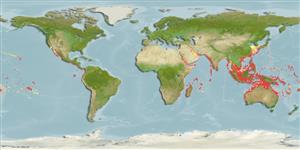Common names from other countries
Environment: milieu / climate zone / depth range / distribution range
Ecologia
marinhas associadas(os) a recifes; intervalo de profundidade 0 - 80 m (Ref. 86942). Tropical; 35°N - 31°S, 30°E - 77°W
Indo-Pacific: from Kwazulu-Natal, South Africa, north to Mie Prefecture, Japan and east to southwestern coast of Baja California Sur, Mexico and Gulf of California to Ecuador (Ref. 9283).
Comprimento de primeira maturação / Tamanho / Peso / Idade
Maturity: Lm 32.5 range ? - ? cm
Max length : 120 cm TL macho/indeterminado; (Ref. 11441); common length : 75.0 cm FL macho/indeterminado; (Ref. 9283); peso máx. publicado: 15.0 kg (Ref. 30874)
Espinhos dorsais (total): 8; Raios dorsais (total): 18-20; Espinhos anais 3; Raios anais : 15 - 17.
Adults occur in deep lagoon and seaward reefs where they feed by rooting for crustaceans and fossorial invertebrates in the sand but they also feed on small fishes (Ref. 9710, 90102). Small juveniles live among the tentacles of jellyfish (Ref. 9710). Adults form schools and are also noted for their behavior to closely swim around sharks and other large fishes, and also follow divers (Ref. 10361). Juveniles particularly display this piloting behavior to gain protection from likely predators (Ref. 9710, 90102). Marketed fresh and salted or dried (Ref. 9283). Juveniles are used in the aquarium trade. Minimum depth reported taken from Ref. 128797.
Ciclo de vida ou comportamento de acasalamento
Maturidade | Reprodução | Desova | Ovos | Fecundidade | Larvas
Smith-Vaniz, W.F., 1995. Carangidae. Jureles, pámpanos, cojinúas, zapateros, cocineros, casabes, macarelas, chicharros, jorobados, medregales, pez pilota. p. 940-986. In W. Fischer, F. Krupp, W. Schneider, C. Sommer, K.E. Carpenter and V. Niem (eds.) Guia FAO para Identification de Especies para lo Fines de la Pesca. Pacifico Centro-Oriental. 3 Vols. FAO, Rome. (Ref. 9283)
Status na Lista Vermelha da UICN (Ref. 130435)
CITES (Ref. 128078)
Not Evaluated
Uso pelos humanos
Can't connect to MySQL database (fbapp). Errorcode: Too many connections
